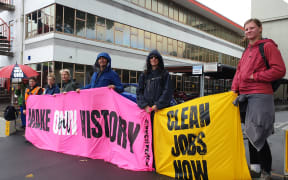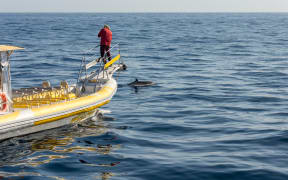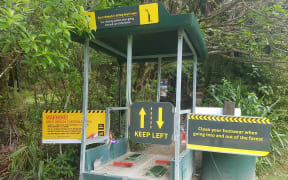Just four percent of philanthropic funds from groups that identify as supporting the environment actually went to environmental causes in 2017/18.

A network of organisations that give money to the environment have commissioned a report to find out how much is being spent, with aims to improve giving to environmental causes. Photo: Unsplash / Tyler Lastovich
But those groups are trying to improve the amount they give to the environment, and say there's also a lack of requests for money for environmental causes.
The finding comes from a recently released study of Philanthropy New Zealand's environmental funders' network, a bid to find out how much money was going to environmental causes.
The report found 412 organisations identified themselves as funding the environment.
Sixty-six of them had public information showing they actively funded the environment. In addition, 36 local authorities provided environmental funding to community groups through grant making processes.
All up, they produced environmental funding of $34.9 million. Without local authorities it came to $26.6m.
That money was just 4 percent of total philanthropic funds those groups gave.
The study was commissioned by the environmental funders' network, who wanted to improve their environmental philanthropy.
Philanthropy NZ chief executive Sue McCabe said the network had felt the environment was underfunded - particularly given what was known about climate change.
The study "proved what anecdotally we have heard, that a low percentage of philanthropic funds are going to environmental causes … There is a general feeling in the sector that 4 percent is not enough".
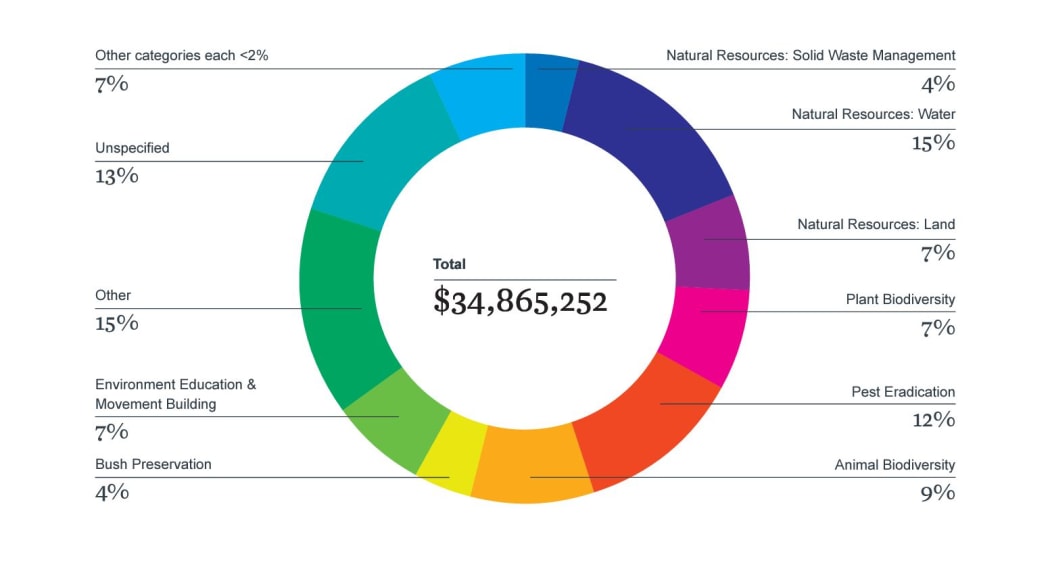
Money given by the environmental funders' network by category, including local government. Photo: Philanthropy New Zealand Environmental Funders' Report
Wellington Community Trust was one of the original supporters of the report. It recently announced $2.1 million in funding for climate change action in the region. It's hoped that funding will be up and running from mid next year.
Trust chief executive Georgie Ferrari said the low amount of money going to the environment wasn't a surprise.
"(It's) one area that we are consistently the lowest in funding and it's not because we knock applications back, it's just that we don't get them.
"I think people don't know to ask for it because we're not explicit enough in telling them we fund [the environment], and then because people don't ask for it, we fund less.
"So maybe environmental groups look at us and look at what we've funded and go, 'Oh, no, they probably wouldn't fund us because they haven't funded much an environment space'. So it's a wee bit of a vicious cycle."
She hoped the study would encourage more environmental funding, saying "First, you've got to be aware of the issue in order to address it".
Ms McCabe said: "We have heard from a number of our members that any environmental funding they have is undersubscribed. So they are not getting the requests for environmental funding like they do in other areas (where) demand for the funding way exceeds the supply."
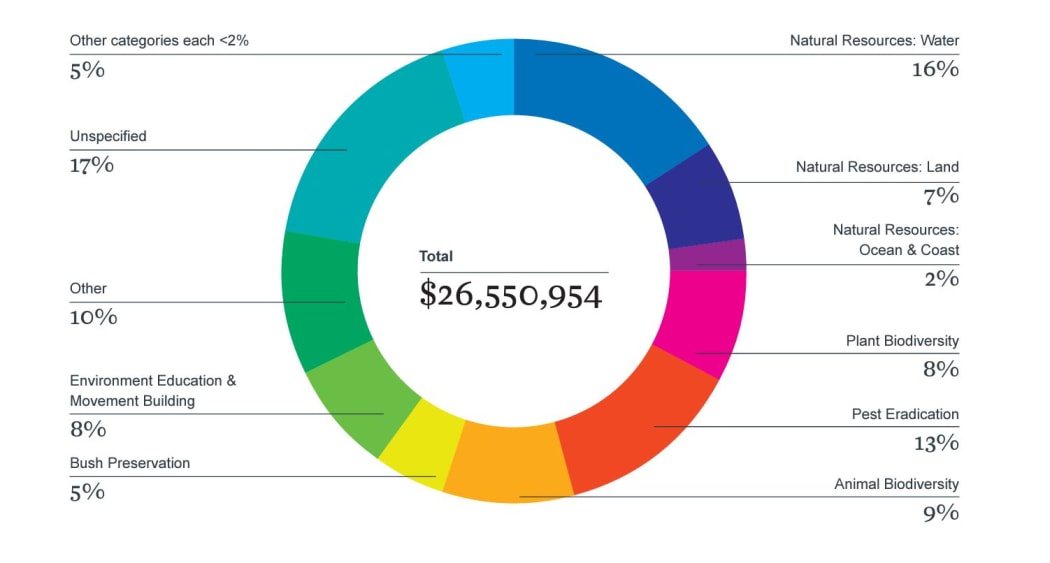
Money given by the environmental funders' network by category, not including local government. Photo: Philanthropy New Zealand Environmental Funders' Report
Turning the tide
But Ms McCabe said the environmental funders were "seeking to be really responsive to changing community needs".
Since the study was conducted, a number of the funders had already worked to increase funding to the environment, Ms McCabe said.
She expected that if the research was done again, there would be an increase in environmental funding.
Going forward, work was needed to help connect those with the money to those who needed it - and make them aware it was there, she said.
Ms Ferrari said funders "definitely" had a responsibility to do "be more explicit about what we want to fund and how we fund".
"I think there are three things we have to do. I think, as individual funders we have to engage better with our local environmental groups and part of that is being explicit about what we will and won't fund. So we need to do that education and that outreach.
"Secondly, as individual funders, we have to get better at applying an environment lens to our work. So looking at when we have a funding round, we need to look and go 'OK, so have we funded well in the environment space? So we need to be reflective. And make sure we're always looking at that grant making with that environmental lens. Have we funded anything that will be negative for the environment? That's the other side of it.
"The third thing is, I guess, more systemic, which is as a sector across the country, we need to engage with the environmental sector and talk about and understand better how they are funded, where their gaps are and what our role could be."
Ms Ferrari thought if those things could be achieved, the amount of environmental funding would increase.
Ms McCabe said PNZ would support the environmental funders' network to increase the amount.
She also noted that the research had understated how much environmental funding there was.
"It looks at a particular type of funder. We didn't look, for example, at the money that individuals are pushing through Givealittle to environmental groups, we didn't look at personal donations.
"What we looked at was funders, organised funders, who tagged themselves on the charities register as saying that they fund the environment. And then we also looked at local authorities - who are obviously not registered charities - but they do grant money to community groups for a range of things, including environment... It doesn't look at central government funding that goes to community groups that's contestable. And [that's] significant."
It didn't look at individual donations, either.
Those could be "be small and many, or can be quite considerable from high net worth individuals that don't necessarily have a charitable foundation that we would have looked at", Ms McCabe said.
"There's so much giving in New Zealand that happens anonymously. So this research does understate environment funding, however, it shows in the organized giving sector that the funding going to the environment is quite low."
For example, Greenpeace received $9.51 million from New Zealanders in 2018.
Since 2010, yearly donations to the non-profit have ranged between $8.6 and $10.9 million.
To maintain independence, Greenpeace didn't accept funding from government or business. It was almost entirely funded by kiwis giving regular monthly contributions, it said.
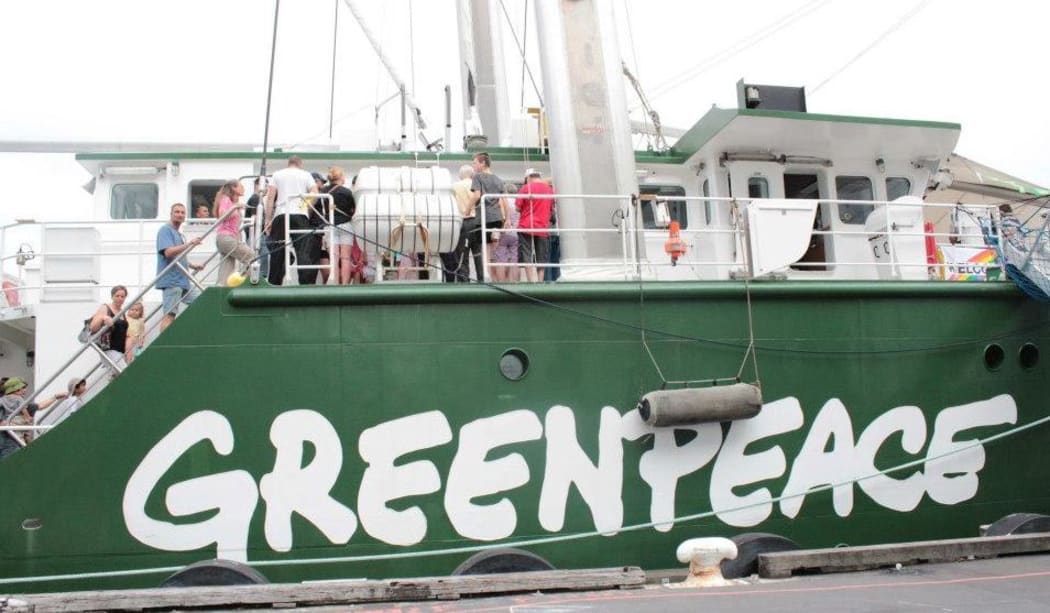
Greenpeace received $9.51 million from New Zealanders in 2018. Photo: Greenpeace New Zealand
Greenpeace's fundraising director, Luke Edwards, said the environment ranked quite lowly as a proportion of overall charitable giving from individuals, and it was similar for philanthropic giving.
Mr Edwards said Greenpeace expected that to change as the environmental crisis started to become more apparent.
While giving was similar five years ago, it had become an "increasingly competitive situation" that made it harder to raise funds, Mr Edwards said.
"There are more than 27,000 registered charities in New Zealand, all needing donor support. Many are using the same channels and methods to seek support. New Zealanders are very generous, but this competitive situation does make fundraising increasingly challenging."
Another aspect that was changing was the motivation for funding environmental causes.
"Recently, people are increasingly motivated by the climate emergency, and although we have not yet seen this translate into a significant increase in donations, we expect it to."
Previously, conservation had been the primary motivator - for examples, protecting wilderness areas or animal species.
Audience research had shown Greenpeace a key motivation for donating was to safeguard the environment for future generations.
Having a specific goal helped inspire donation, too.
Examples for Greenpeace included the campaign to ban single-use plastic bags or when it raised $100,000 in a week to buy a boat and used it to confront the oil industry at sea.
"This was a great example as donors had a very tangible thing to contribute to and were also able to participate in the naming of the boat and follow its journey as it successfully disrupted oil exploration," Mr Edwards said.
Ms McCabe said despite the data from the PNZ study having limitations, it was still helpful.
"They (environmental funders) can look at this data now and they can start to think where the gaps. where the areas they might want to focus on and how might they want to work together around increasing funding to the environment."
